Patent MarketPlace: Wind Power, Solar Power and Other Energy Patents
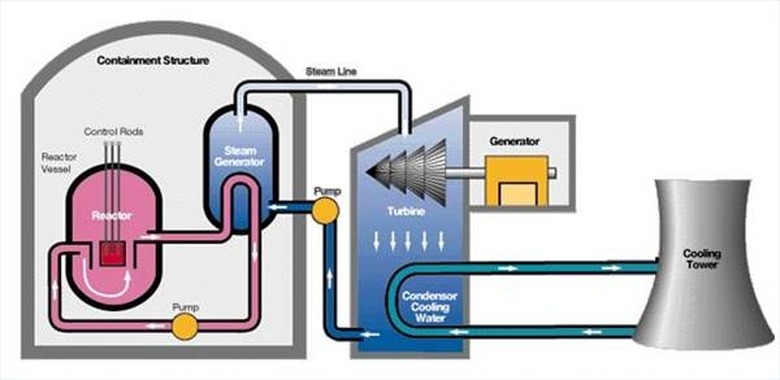 More Thermally Efficient Energy Conversion in Steam Generators (Stankovic): U.S. Patent No. 12,404,784
More Thermally Efficient Energy Conversion in Steam Generators (Stankovic): U.S. Patent No. 12,404,784
Steam generators are a key element in today’s power grid. Trash is burned and the heat creates steam that powers a generator. Heat from a nuclear reaction turns water into steam that powers a generator. Combined cycle plants use waste heat to create steam that powers a generator. But while steam generators are critical elements in power generation, the technology behind today’s steam generators has not significantly advanced in decades.
This patent creates a modified Rankine-cycle plant configuration for achievement of much more thermally efficient energy conversion of the heat exchanged in steam generators as well as other heat-addition devices and appliances. The concept includes a modified Rankine-cycle without rejection of the cycle waste heat. This is enabled and driven by a thermocompressor (ejector) operating in the wet-vapor region. Since there is no cycle waste heat rejection, the theoretical cycle thermal efficiency of the modified Rankine cycle is the maximum possible (~100%). The wet-vapor mixture circulated within the thermocompressor is separated in a cylindrical separation tank, and the saturated water is pumped to a water heater and optionally to a steam reheater (or steam generator) where it receives the cycle heat input while the saturated vapor is expanded in a backpressure steam turbine producing useful mechanical work. It is then recirculated back to the thermocompressor where it is being re-pressurized by the primary fluid (pumped and heated saturated water).
U.S. Patent No. 12,404,784 for a “Modified Rankine cycle without heat rejection, driven by a wet-vapor-region thermocompressor” would enable any power plant contractor to use the technology in steam-turbine-cycle power-plants fueled by coal or solid/liquid/waste fuel, nuclear fuel (using boiling water reactors, pressurized water reactors, pressurized heavy-water reactors, gas-cooled reactors, molten salt reactors, or liquid-metal-cooled fast reactors), or renewable energy (solar energy, biomass, or geothermal). The concept can also be used in the bottoming steam-turbine-cycle part of a combined gas-turbine/steam-turbine cycle power plant.
 Portable Power Anywhere at Any Time (Buck): U.S. Patent No. 11,799,400
Portable Power Anywhere at Any Time (Buck): U.S. Patent No. 11,799,400
We are all spoiled with power all around us. We just plug in any electrical appliance or device, and we receive instant gratification. It is a common scene at airports and coffee shops to see customers who have plugged in their phone chargers in. Electric vehicle charging stations are popping up all over to keep the growing fleet of EVs charged. But what do you do when there is no power?
The local power is knocked out by a storm or flood or other natural disaster. Or you are camping, hunting, fishing, mountain climbing, cave exploring, or some other activity in the great outdoors where the grid does not go. Solar provides limited power if and when the sun is shining. But once your batteries go dead by the side of that beautiful lake out in the middle of nowhere, you are stranded with NO power! This patent creates a power-generation device that is human-powered. It consists of a plurality of stator magnets and rotor magnets that are mounted on the outside or inside of the unit, and a shaft is connected to the rotor magnets. A human spins the flywheel and then compresses the magnets to engage the rotary motor. The stator magnets and the rotor magnets begin to repulse to create rotational force, and that force can be used to generate electrical power anywhere and at any time. No fuel or sun or wind required. Just a human being to start the rotor turning.
U.S. Patent No. 11,799,400 for a “Compressed inverted magnetic energy source” can be used to create an emergency power source for homes and businesses or a portable power generator for sportsmen and adventurers.
 Carbon Utilization from Carbon Dioxide (Ecokap): U.S.-European Patent Portfolio
Carbon Utilization from Carbon Dioxide (Ecokap): U.S.-European Patent Portfolio
The culprit in global warming is carbon dioxide – CO2. Fossil fuels produce CO2, so reducing CO2 can be done just two ways – stop burning fossil fuels (not very practical or realistic) or find a way to remove the carbon from all that CO2 power plants and other facilities are pumping into the air. Fossil fuels are hydrocarbons – they are composed of carbon (C), hydrogen (H), and oxygen (O). When burned, hydrocarbon fuels emit H2O (water vapor) and CO2 (carbon dioxide). What if we re-organized those elements into a more useful combination?
That is exactly what this portfolio does! Rather than attempting to prevent the creation of CO2 as a byproduct of combustion, it uses a high-pressure, high-temperature reactor that operates upon a blend of carbon compound, a carbon source, a catalyst, and steam. Microwave power is directed into the reactor, and the catalyst – preferably magnetite – acts as a heating media. The microwave power and the temperature of the reactor rises to a level that converts the carbon and steam into hydrogen (H2) and carbon monoxide (CO), creating a syngas that can then be converted into high-value synthetic fuels and chemicals such as methane, diesel and jet fuel, and ammonia. The strategy is carbon monetization – NOT carbon sequestration! There is also a patent in the portfolio that addresses extraction of nitrogen.
Ekocap Portfolio
- U.S. Patent No. 8,779,013: Apparatus for converting greenhouse gases into synthetic fuels
- U.S. Patent No. 9,238,214: Apparatus for converting greenhouse gases into synthetic fuels
- U.S. Patent No. 9,353,323: Method and apparatus for producing liquid hydrocarbon fuels
- U.S. Patent No. 9,617,478: Apparatus for converting greenhouse gases into synthetic fuels
- U.S. Patent No. 9,617,486: Method and apparatus for producing liquid hydrocarbon fuels
- U.S. Patent No. 9,932,230: Conversion of greenhouse gases by dry reforming
- U.S. Patent No. 9,993,797: Microwave-assisted conversion of carbon dioxide to carbon monoxide
- U.S. Patent No. 10,053,634: Nitrogen extraction from a gaseous carbon dioxide reactant stream
- U.S. Patent No. 10,343,134: Microwave irradiation of a chamber with time-varying microwave frequency or multiple microwave frequencies
- European Patent 3370861: Microwave irradiation of a chamber with time-varying microwave frequency or multiple microwave frequencies
This portfolio – or select patents from the portfolio – can be used by any constructor of coal and natural gas generators, steel mills, pulp and paper plants, refineries, cement plants, chemical plants, and process manufacturing facilities to create a cleaner form of energy from the most plentiful sources of fuel currently available. The technology can be designed into future power plants or adapted to enable current plants to reduce greenhouse emissions. In addition to reducing harmful emissions, the power plant will produce syngas that will generate an entirely new source of income.
 Closed-Circuit Hydroelectric Power Generation (Associated Power): International Patent Portfolio
Closed-Circuit Hydroelectric Power Generation (Associated Power): International Patent Portfolio
Hydroelectric power is the cheapest and cleanest source of electricity. As long a water continues to run downhill – as long as we have gravity – rivers can be dammed to create hydroelectric plants. In addition to being green, there is no fuel to purchase, so the only ongoing costs are maintaining the facility. That’s the good news. The not so good news is that all the rivers that can be dammed have been. That’s why we are not building new hydroelectric plants.
This patent portfolio covers the next-generation of hydroelectric power generation by creating a closed system in which the same water is circulated over and over. This technology works by maintaining a constant state of imbalance. Gravity attempts to rebalance this imbalance by continually displacing a volume of water to a higher level. In doing so, g-force is converted into gravitational potential energy, then into kinetic energy, and then into mechanical energy that is used to generate electricity. The magic behind the technology is that it generates more power than is needed to maintain the circulation of the hydrodynamic system. Of the total input g-force, approximately 60% can be converted into useful power while the remaining 40% is used to maintain the system and overcome friction – conforming to the Law of Conservation of Energy. The concept is 100% proven, and it is totally scalable, so closed-circuit hydroelectric power plants can be built anywhere and sized to the needs of the service area.
Patent Portfolio
- U.S. Patent No. 11,913,425: Energy conversion system
- European Patent 3966445: Energy conversion system (Valid in Germany, UK, France, Italy, Netherlands, and Spain)
- China Patent 114072575: Energy conversion system
- Japan Patent Application 2022537637: Energy conversion system
This portfolio will enable any manufacturer of power generation equipment to take to market a totally new and very profitable source of 100% renewable electric power that generates three times the output of an equivalent sized wind turbine and six times that of a solar panel!
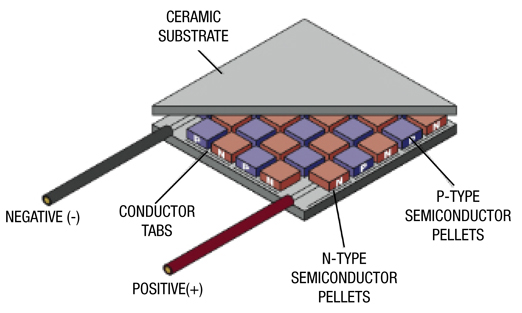 Film-Based Thermoelectric Elements and Modules (Iosad): U.S.-European Patent Portfolio
Film-Based Thermoelectric Elements and Modules (Iosad): U.S.-European Patent Portfolio
One of the major advances in power generation is the growth of thermoelectric generators. These devices capture heat from factories, refineries, chemical and food plants, and other facilities to generate electric power from energy that was previously waste. As a result, demand for thermoelectric generators is huge and continues to grow. Any incremental improvement in the efficiency of thermoelectric generators will have a significant impact. Various electronic devices such as drones, especially underwater drones, a wide range of Internet of Things devices, and remote or medical sensors are equipped with thermoelectric generators to make them autonomous and eliminate the need for regular battery replacement. Thermoelectric elements and modules of this portfolio can also be used as heat pumps as well as for building climatization, especially in combination with thermal storage materials.
Thermoelectric modules are flexible and, therefore, suitable for large-area applications – for example, they can be integrated into walls of compartments. Moreover, the density of the thermoelectric elements can be adapted according to the density of heat fluxes. This portfolio’s technology is applicable to thermoelectric elements employing single layers of p-type or n-type thermoelectric layers as legs and p-n junctions. The scope of protection of the portfolio includes substrate-based and substrate-free thermoelectric elements. Printed circuit boards with metallization pads can be employed as substrates. The substrate-free thermoelectric elements employ metal foil electrodes. Such a configuration enables substantial price reduction and roll-to-roll manufacturing with high throughput. Thermoelectric legs can be formed by additive technologies like printing.
The p-n junction configuration is more efficient than conventional thermoelectric elements employing single p or n legs. A thermal gradient applied along the interface of a p-n junction decouples the looped generation-recombination currents in the p-n junction. These are at least one order of magnitude higher than the net current between the electrodes of the p-n junction.
U.S.-European Patent Portfolio
- U.S. Patent Application 20240292755: Thermoelectric elements, thermoelectric modules, and methods for manufacturing thereof
- U.S. Patent Application No. 18/683,054: Thermoelectric elements, thermoelectric modules, and methods for manufacturing thereof
- European Patent Application 4396858: Thermoelectric element, thermoelectric generator, peltier element, peltier cooler, and methods manufacturing thereof
- European Patent Application 24196557.3: Thermoelectric element, thermoelectric generator, peltier element, peltier cooler, and methods manufacturing thereof
- German Patent 102021209656: Thermoelectric element, thermoelectric generator and method for their manufacture
- German Patent Application 102023104908: Thermoelectric elements, thermoelectric modules and methods for their manufacture
- PCT Patent Application 2023031369: Thermoelectric element, thermoelectric generator, peltier element, peltier cooler, and methods for their manufacturing
- U.S. Patent Application 11,815,063: Hydro power plant
- European Patent Application 3921537: Hydroelectric power plant
- Canada Patent Application 3129332: Hydroelectric power plant
- PCT Patent Application 2020160786: Hydroelectric power plant
- U.S. Patent No. 9,784,293: Utility pole mounted solar panels and securing brackets
- U.S. Patent No. 9,847,748: Utility pole mounted solar panels and securing brackets
- U.S. Patent No. 10,523,151: Utility pole mounted solar panels and securing brackets
- Canadian Patent Application 3013719: Utility pole mounted solar panels and securing brackets
- European Patent Application 3411949: Utility pole mounted solar panels and securing brackets
- Campers, RVers, fishermen, hunters, hikers, scientists and explorers who need power out in the wilds
- Power for irrigation systems or construction where local power is not available or convenient
- Power for remote or third-world communities that are not attached to the grid
- Emergency power using a battery or storage device to save power generated during the day for power overnight
- Power for the military to charge batteries or run electronic equipment that is quiet and inconspicuous, and also frees up gas and diesel fuel for vehicles and equipment
- Novel, low-friction, swivel-positioning device that provides a significant improvement in tracker performance
- Swivel-positioning device allows rotation on a ball joint unlike conventional solar tracker positioning devices that pivot or rotate around an axis
- Rotation of the ball joint allows array rotation within the plane of incidence for shading avoidance
- Provides a full range of motion, ensuring that the maximum sunlight is captured and retained for optimal performance with a photovoltaic capture of 97% at 30 degrees latitude
- Low-friction movement means minimal tracker-energy consumption
- Effective and efficient tracking of the sun with a panel or array of panels
- Supplies the power required by a load circuit, based on demand by industrial, commercial and residential users of electric utility power while simultaneously conserving the power supplied by an AC utility power source, and thereby decreasing the load on the national electrical grid
- Actively monitors and controls to achieve minimum consumption of electric utility power from the local utility
- Provides increased capabilities, additional DC rechargeable energy source, additional charging capacity, and additional inverting capacity
- Provides three configurations of the power conservation system for various applications
- Incentifies use of more green-power generation solutions
- Provides high wind power recovery at low heights so they are not harmful to flying
- Produces less noise, which results in reduced noise pollution when several of these devices are installed in a specific area
- Operable at any location, without any difficulty or performance reduction
- Vertical axis requires no wind-sensing mechanisms in order to generate electricity
- Scalable design means units can be sized to power, space or transport requirements
- Motor and ring gear assembly control the direction of the housing so it catches optimal wind power
- Major power generating components such as the gearbox and generator are located towards the base of the turbine, so maintenance and repair activities are relatively more convenient
- Executive Summary
- Patent Overview and History
- Technology and Investment Summary
- Market Research
- Company Analysis
- Illustrative Evidence of Use (if applicable)
- Agricultural
- Artificial Intelligence
- Automotive/Vehicular
- Aviation
- Banking/Financial Services
- Beverages/Foods/Nutritional Products
- Boat and Marine
- Cannabis and Medical Marijuana
- Construction/Building Trades
- Consumer Electronics
- Consumer Products
- Digital Currency/Cryptocurrency
- Drones/UAVs
- E-Cigarette & Vaping Technology
- E-Commerce
- Education & Training
- Energy/Power Generation
- Health and Beauty Products (HBP)
- IoT Patents/Internet of Things
- Manufacturing
- Medical Electronics and Devices
- Mining/Drilling
- Mobile/Wireless
- Network/Location-Based Services
- Optics/Displays/Video/LED
- OTT Patents/Over-the-Top
- Packaging
- PCs and Notebooks
- Pharmaceuticals
- Robotics/Automation
- Semiconductor
- Shoe & Apparel
- Smart Home/Smart Office
- Social Media
- Software, Apps, and Architecture
- Sports/Sporting Goods
- Telecommunications/IP Telephony
- Warehousing/Material Handling
- Other
- Go to Patent Index
- Return to Patent MarketPlace
This portfolio will enable any U.S. or European manufacturer of thermoelectric generators to introduce next-generation thermoelectric generators with a figure or merit approximately twice as high as that of Bi2Te3-based thermoelectric generators!
 Managing the Variability of Renewable Energy (Billian Energy): U.S. Patent No. 8,731,732
Managing the Variability of Renewable Energy (Billian Energy): U.S. Patent No. 8,731,732
About 80% of the power supplied by electric utilities in the U.S. is hydro, nuclear, or fossil fuel, with just about 20% coming from new, renewable sources. There is a significant difference between hydroelectricity, nuclear power, and fossil-fuel-generated power and the new, emerging sources of renewable energy such as wind and solar. Hydro, nuclear, and fossil fuel-sourced electric power are constant. Hydroelectric turbines, nuclear power plants, and coal and natural gas power plants crank out power day and night on a highly reliable basis. Good weather, bad weather, they generate a steady, reliable, and predicable stream of electrons. This is not true of wind and solar. There is NO wind power when there is no wind, and NO solar power when there is no sun. These newer sources of power are neither steady, nor reliable, nor predictable. And that presents a real challenge for electric utilities that will increasingly be relying on renewable sources of electricity to supply to their customers.
Add to the variability of solar and wind power the fact that demand for power changes during the day. It is highest mid-afternoon when all those AC units are running full out, and lowest in the early morning hours when most of us are asleep. This patent addresses the double challenge that electric utilities face in what is known as “grid balancing” – juggling the power coming into the utility from hydroelectric plants, nuclear power plants, fossil fuel plants, solar farms, and wind farms – against the power needs of the utility’s customer base. It continually analyzes the inflow and outflow of power to provide a sum load response.
U.S. Patent No. 8,731,732 for “Methods and system to manage variability in production of renewable energy” would enable any electric utility or provider of services to electric utilities to better manage the grid balance, thereby preventing brown-outs and reducing costs for the utility.
 Floating Hydroelectric and Sea Currents Power Plant (Sklivanos): International Patent Application Portfolio
Floating Hydroelectric and Sea Currents Power Plant (Sklivanos): International Patent Application Portfolio
Hydroelectricity is a very economical source of electric power. Once the initial investment in the facility has been made, operating expenses are minimal and there are NO fuel costs. The problem with hydroelectricity is that virtually all of the rivers in the industrialized nations that can be dammed for hydroelectricity have been dammed – from Niagara Falls to Hoover Dam and hundreds in-between.
This patent application portfolio takes hydroelectric power to the next level by creating a floating hydroelectric power plant! No piles have to be driven and no cement needs to be poured. This portfolio covers a device that floats on the surface of the water while a continuous belt of blades is driven by the current. This technology can be used in rivers where a dam and powerplant cannot be built, but there is a flow velocity of at least 0.5 meters-per-second. The technology can also be used in any of the oceans in the world using sea currents – for a continual and virtually free souce of electricity. A floating hydroelectric power plant based on this portfolio can be configured in different sizes based on the location in which it will be used, and will likely generate from 50 kilowatts to two megawatts in a river location, more using sea currents.
Patent Portfolio
This portfolio creates an opportunity for any manufacturer of electrical generation equipment to introduce a totally new concept in small-scale hydroelectricity. And the acquirer of the portfolio can use the PCT Patent Application to secure additional patent protection anywhere in the world.
 Higher Efficiency Ocean Thermal Energy Conversion (Cowden): Two U.S. Patents
Higher Efficiency Ocean Thermal Energy Conversion (Cowden): Two U.S. Patents
The search continues for sources of renewable green energy. All the rivers in the U.S. that have the capacity to produce hydropower have been dammed. Solar and wind are being widely implemented, but they both have limitations. Energy generated from the ocean using the difference between the colder deep water and the warmer shallow water - Ocean Thermal Energy Conversion (OTEC) – is just beginning to be exploited. This patent portfolio takes that technology to the next level.
This invention covered by this portfolio uses a working fluid such as ammonia with a Rankine cycle along with a heat exchanger that includes a fluid transfer assembly, a pump, a heater, a turbine, and a generator. The fluid transfer assembly utilizes a condenser conduit to condense working fluid by transferring the fluid to the cold depths of the ocean before returning it to the warm surface through an insulated return conduit. The working fluid is vaporized by a heater before entering a turbine connected to a generator to produce electricity. A second heater may be added to the system to create an Ocean Thermal Energy Conversion power plant that also produces potable water!
This patent family includes U.S. Patent No. 8,572,967 for a “High efficiency OTEC system” and U.S. Patent No. 9,032,732 for a “High efficiency OTEC service station.” This portfolio would be a strategic acquisition for any manufacturer of power generation stations – either as a path to enter the OTEC segment or to leapfrog the technology of other OTEC generation station OEMs.
 Smarter Battery Charging (Sioma): Two U.S. Patents
Smarter Battery Charging (Sioma): Two U.S. Patents
What happens when a battery recharger does not have an accurate controller that turns off the charger after the battery is fully charged? At the very least, it shortens the battery life. At the very worst, it can result in a battery fire! The larger problem is that if your battery charger is not turning itself off when the battery is fully charged, you do not know, so – unbeknownst to you – your battery charger is dramatically shortening the life of your battery.
This portfolio covers technology for active-error correction for battery chargers. U.S. Patent No. 9,570,933 covers high-voltage batteries while U.S. Patent No. 10,992,157 covers batteries up to 48 volts. Both patents include technology that eliminates errors due to resistive elements such as the internal resistances of the power source, cables, cable connectors, and the battery itself. These patents do not simply create better battery charging – their design is based on Amplitude Modulation (AM) as the primary source of power and the elimination of the inherent errors in current charging systems.
Charging systems based on this portfolio can use either AC or DC current, so both regular 120 Volt AC wall current can be used, or a DC source of power such as solar panels with the addition of a one-chip circuit. It will charge any type of rechargeable battery in a wide range of voltages, and can be stationary or mobile. Because all errors are removed during the charging process, the batteries are always charged fully. A battery charger based on this portfolio can be constructed from available parts, and it can be analog or digital.
U.S. Patent No. 9,570,933 for a “Charging system having active error correction for rechargeable batteries” and U.S. Patent No. 10,992,157 for a “Battery charging system that utilizes a full wave rectifier and maintains active error correction with a sample and hold circuit” would enable any manufacturer of battery chargers to offer the next generation of products. For the charging of batteries in electric vehicles, this technology will increase the driving range by ensuring a full battery charge, and increase the life of the battery, reducing the cost of EV ownership.
 Utility Pole Solar Power Generation (Kornovich): International Patent Portfolio
Utility Pole Solar Power Generation (Kornovich): International Patent Portfolio
Utility poles are used to deliver electrical power to homes and businesses. But they have another application that is largely under-utilized. They can be used to hold solar panels so that each utility pole becomes a solar power generation station. Rooftops are being used for solar panels, and we see solar farms popping up all over, but there are 180 million utility poles in the U.S., and most of them are out in the open and exposed to the sun most of the day.
This international portfolio addresses exactly that opportunity. It includes specialty brackets that attach to any utility pole. These brackets hold three solar panels, one facing east, one facing south, and one facing west, so power is generated from sun-up to sun-down. The panels can be set at any pitch to optimize power generation, and the power from the solar panels can be used directly, sent into the grid, or saved to a battery. In times of power outages and natural disasters, emergency power kits containing the brackets and panels can be affixed to utility poles to produce power!
Patent Portfolio
This portfolio – or selected patents in the portfolio – would be a strategic acquisition for any solar energy business or a company that supplies products to electric utilities.
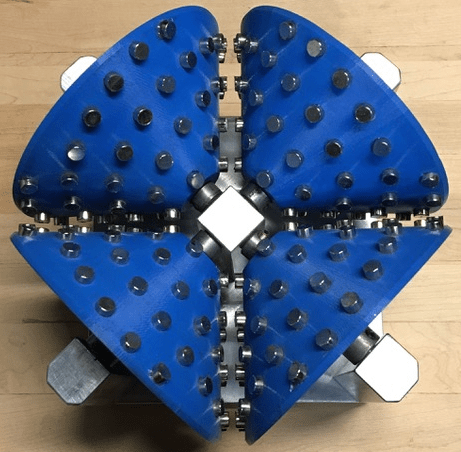 Six-Axis Frictionless Gear System (Leas): U.S. Patent No. 10,224,798
Six-Axis Frictionless Gear System (Leas): U.S. Patent No. 10,224,798
“It is not movement that destroys the machinery, but friction.” So said Henry Ward Beecher, a 19th Century clergyman and abolitionist. While not an engineer by trade, Henry summarized a key factor in the coming Industrial Revolution. One of the most critical issues in any mechanical device is not just the power it generates, but the friction it produces. A key factor in the efficiency and longevity of any mechanical device is the minimization of friction in its design and operation.
The invention covered by this patent takes the reduction of friction to a new level by creating a non-contact, magnetic, spiral bevel gear from two-axis to six-axis construction, allowing for a multitude of variables in the gear design. This style of magnetic gearing provides a means to transmit motive power from one axis to another axis without any physical contact using magnetic fields as a non-contact means of transferring rotational power, creating a non-friction gear system. The benefits of non-friction, non-contact gearing are many. It reduces over-torque system breakaway and shaft gear repairs, and eliminates shaft-and-gear mis-alignment. The technology covered by this patent creates next-generation machinery that runs cooler, quieter, and lubrication-free, and is not subject to the wear and breakdowns of conventional hard-contact gearing systems.
U.S. Patent No. 10,224,798 for a “Magnetic spiral bevel gear” has applications in flywheel energy storage, wind turbines, hydropower, and other forms of power generation.
Incorporation of a six-axis magnetic gearing arrangement into a motor or generator reduces the gyroscopic action caused by the current generation of motors and generators. This technology can be applied to automobiles, trucks, busses, construction equipment, and other vehicles to produce frictionless gearing. This revolutionary concept can be scaled up or scaled down as needed, and can be applied to the fabrication of a drive component or be composed upon a drive shaft as a part of an electrical generator element that can help recharge the battery or send power to capacitor-based energy storage.
 Wind, Solar and Tidal Power Generator (PEN): U.S. Patent No. 10,526,056
Wind, Solar and Tidal Power Generator (PEN): U.S. Patent No. 10,526,056
Solar farms and wind turbines are an increasingly common sight these days. And green energy is steadily taking over a larger and larger share of the power generation pie. According to the U.S. Energy Information Administration, fossil fuels have dropped to 62.7% of electric power generation while renewables have grown to 17.5%. One of the drawbacks of solar, wind and tidal power is that none of them can produce power 24/7 like a fossil fuel plant can.
This patent addresses the shortcomings of wind, solar and tidal power generation by merging the three technologies into one device! This patent describes a buoyant platform with blades that capture tidal movement. Mounted on the buoyant platform – not the ocean floor – is a wind turbine. Also mounted on the platform and on the wind turbine blades are solar panels that generate electricity in the absence of wind. This green energy generation device can produce power 24/7. The tidal part of the device and the wind turbine generate electricity at night or when it is overcast, and the solar panels kick in on sunny days.
The patent does not simply merge tidal, wind, and solar into a single electrical power generation system, the patent also includes an improved design for solar panels. The patent describes solar panels that are composed of hemicylindrical channels that increase the surface area by a factor of 1.57. With a thickness of about 0.2 inches, the solar panels create heated, pressurized inner chambers through which flows heated water.
U.S. Patent No. 10,526,056 for “Generation of electric power using wave motion, wind energy and solar energy” would be a strategic acquisition for any tidal power generation, wind turbine or solar panel manufacturer that is prepared to expand into multiple green power energy sources.
 Kinetic Energy Amplifier (Bluegranite Media): U.S. No. 10,355,540
Kinetic Energy Amplifier (Bluegranite Media): U.S. No. 10,355,540
Since the invention of the steam engine, every possible effort has been taken to improve the power-producing effectiveness of engines, motors and turbines. And great strides have been made – especially in the last 30 or 40 years – to make gasoline and diesel engines, electric motors, and hydro, steam, wind, tide and wave turbines more efficient. Most of these improvements are based on friction and drag reduction, as well as more efficient transmission of the generated power, such as the eight-speed transmissions in most new cars.
This patent introduces a new factor into the ongoing battle for greater power production – magnetism. This patent creates a “kinetic energy amplifier” array that attaches around the drive shaft of an engine, generator, turbine or electric motor and uses the flux from a series of magnets to increase the power generated by the combination of the engine and the kinetic energy amplifier by as much as 33%! The invention can use either conventional iron magnets or ceramic permanent magnets that are lighter, and it can be scaled up or down to match the power-generation device to which it will be attached. This invention has applications in internal combustions engines, hydro and fossil fuel power plants, steam generators, green energy turbines, electric vehicles, trucks and busses – even aircraft – as a method to substantially increase power, dramatically reduce fuel consumption, increase range, and improve efficiency!
This patented technology can be incorporated into the next generation of engines, motors, turbines and generators, or current machinery can be relatively easily and quickly retro-fitted with kinetic energy amplifiers, creating an aftermarket product line that boosts energy output. U.S. Patent No. 10,355,540 for a “Magnetic drive enhancement” would be a strategic acquisition for any manufacturer of turbines, generators, internal combustion engines and electric motors, as well as any vehicle or aircraft manufacturer.
 Power from Turbines During Periods of Low Air Flow (Arduini): Two U.S. Patents
Power from Turbines During Periods of Low Air Flow (Arduini): Two U.S. Patents
Wind turbines are a common sight today. And when the air flow is strong and consistent, the turbine is producing power and doing so very economically and ecologically. Tidal and wave-powered units are also highly efficient, green sources of power. But what happens when the wind, wave or tidal velocity drops? We’ve all seen wind turbines sitting idle and not turning – not generating electricity. In that mode, they are very expensive!
The invention covered by this patent family enables operation of wind, wave and tidal turbines during periods of low-flow velocity by temporarily disconnecting the load to allow the turbine's rotating mass to accumulate velocity and energy, and then dump it into a load as an energy pulse. The invention allows low-energy input charging power to be accumulated and then summed or integrated over a longer period. It can then be stored or transferred to an output load such as high-energy output discharging power over a shorter period of time. The result is improved efficiency and extended operating range for wind, tidal and wave turbines during periods of low-flow velocities.
The invention covered by this patent can be combined with the invention covered by U.S. Patent No. 10,247,262 for a “Variable and centrifugal flywheel and centrifugal clutch” – which appears on this page directly below this patent – to create a comprehensive solution to periods of low air, tide or wave flow.
U.S. Patent No. 7,843,077 for a “Pulsed energy transfer” would be a strategic acquisition for any wind, wave or tidal turbine manufacturer, or for an operator of wind, wave or tidal turbines that is looking to increase efficiencies and reduce down-time.
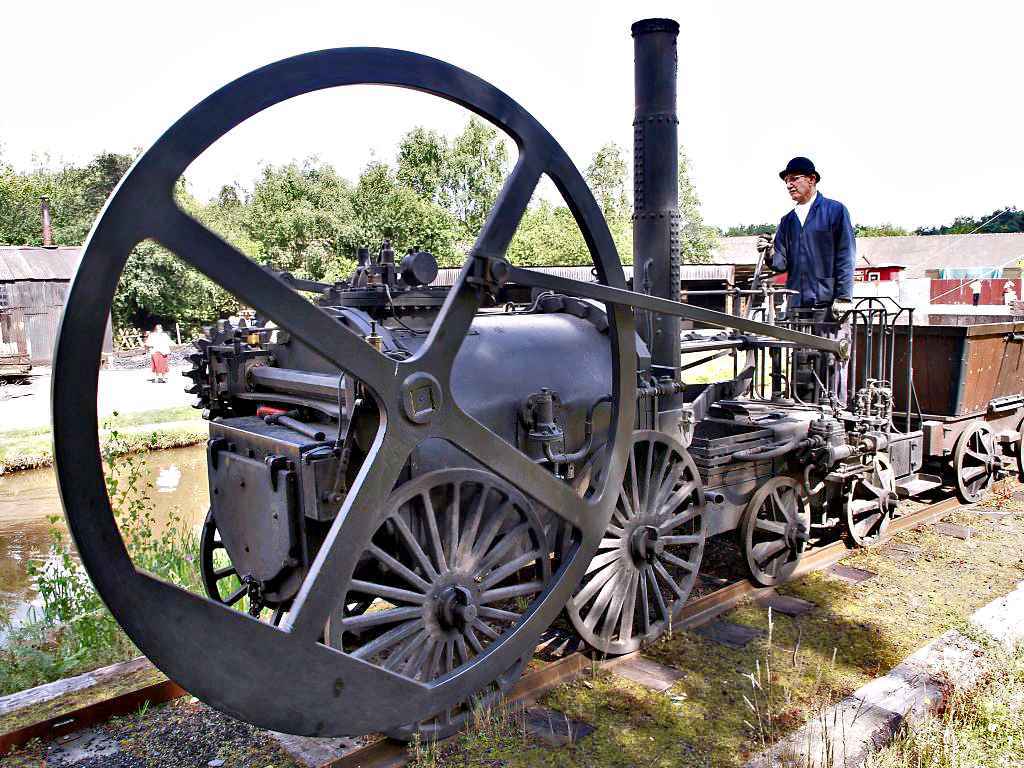 Next-Generation Clutch and Flywheel (Arduini): U.S. Patent No. 10,247,262
Next-Generation Clutch and Flywheel (Arduini): U.S. Patent No. 10,247,262
The flywheel has been a critical component in engines going back to the first steam engine that was invented and patented by Thomas Savery over 300 years ago. James Watt came along and made several improvements to the steam engine, but he retained the flywheel. Flywheels are most commonly used today in internal combustion engines. A flywheel stores rotational energy in reciprocating engines. In a four-cycle engine, for example, there is the exhaust stroke (no power generated there), the intake stroke (no power generated there, either), and the compression stroke (still no power generated). It is only on the power stroke that power is generated. The flywheel keeps everything turning between the power strokes.
The invention covered by this patent takes the 300-year-old flywheel to new levels of performance, especially when coupled with wind, wave or tidal turbines. The invention begins with a centrifugal-force-controlled clutch, an automatic mechanical clutch that is controlled by the RPM of the turbine. The pulsated input power automatically maintains the RPM operating range while increasing the stored energy, leading to improved efficiency during periods of low air, wave or tidal flow.
The invention then incorporates a centrifugal flywheel that automatically controls the variable mass radius that is displaced linearly with RPM for stored energy. The flywheel covered by the invention adjusts to variations in input and output of energy better than the conventional fixed flywheels found on rotating turbines and machines, enabling it to operate near the “sweet spot RPM” for optimal efficiency. This includes the ability to store pulsed or low-energy inputs and transfer, or to discharge the energy as needed for constant long periods or short pulse periods of average or peak power, RPM or torque.
The third element in the invention is an adjustable or variable flywheel that provides a wide range of RPM and variable mass radius displacement control for stored energy versus conventional fixed flywheels on rotating turbines and machines. It maintains a constant RPM, torque or G-force despite variations in input energy, stored energy, output load energy, and input/output pulsed energy, and does so far more effectively than conventional fixed flywheels.
These patents create improved efficiencies and operating characteristics for renewable-energy, energy-saving and energy-storage technologies such as power generated from wind, water and tides. New embodiments are being added in a Division-In-Part to broaden the scope of claims and applications. This patent can be paired with the technology covered in U.S. Patent No. 7,843,077 for a “Pulsed energy transfer” – which appears on this page directly above this patent – to create most comprehensive next-generation wind, wave and tidal turbines. The technology is also applicable to internal combustion and rotary engines, jet and ram/pulse jet engines, motors and generators, centrifuges and gyros, pulsed lasers and launchers/rail guns.
U.S. Patent Nos. 10,247,262 and 11,629,696 for a “Variable and centrifugal flywheel and centrifugal clutch” create an opportunity for any wind, wave or tidal turbine manufacturer to leapfrog the technology of all of its competitors and offer significantly more efficient green-power generation.
 Energy Efficient, High-Torque Electric Motor (Morris): U.S. Patent No. 10,199,914 plus CIP
Energy Efficient, High-Torque Electric Motor (Morris): U.S. Patent No. 10,199,914 plus CIP
Electric vehicle manufacturers are doing everything possible to increase the range their vehicles can go on a charge. In addition to increasing battery capacity, the other strategy to accomplish this is to use electric motors that are more efficient. This intriguing patent addresses exactly that. In fact, it is the first new concept in electric motors in decades!
This patented electronic motor features a shaft that has a larger diameter and shortened length. It essentially “pancakes” the motor. It is a high-torque motor that operates more efficiently by taking advantage of repelling and attracting forces from magnetic fields. It uses lifting electromagnets for improved efficiency, and it includes a fail-safe feature that enables the motor to continue to operate even when some components fail! The inventor has developed a working prototype that can be viewed by any parties interested in the portfolio.
U.S. Patent No. 10,199,914 for “Closed loop leveraging electromagnetic motor” has applications in electric vehicles as well as any products currently using electric motors – such as water pumping stations plus construction and agricultural equipment – where increased efficiency is needed. The granted U.S. Patent comes with a Continuation-in-Part Application that enables the motor to use an app to control and monitor the motor’s parameters. This portfolio would be a critical acquisition for any electric vehicle company or manufacturer of equipment that use electric motors!
 Higher Capacity, Rechargeable Lithium-Air Battery (Miles): U.S. Patent No. 8,795,868
Higher Capacity, Rechargeable Lithium-Air Battery (Miles): U.S. Patent No. 8,795,868
The most significant limitation for electric vehicles is range. Most cannot go as far on a charge as a gasoline-powered car can go on a tank of gas, and charging stations are not nearly as common as gas stations. The next major technological challenge facing electric vehicle manufacturers is improved range, and that means a new generation of lithium batteries that can hold a greater charge. This patent addresses exactly that need!
In a typical lithium-ion battery, lithium ions transfer from the metallic lithium component of the anode electrode into an electrolyte leaving an electron behind, and the lithium ions circulate as positive ions in the electrolyte, replacing the lithium ions consumed at the lithium-ion battery cathode. In next-generation lithium-air batteries, oxygen is passed through the pores in the cathode and introduced into the electrolyte. These negative oxygen ions combine with the lithium ions to produce lithium peroxide and/or lithium oxide. The electrical charges produced by these reactions pass externally between the electrodes to provide external electrical current.
The only way to increase the power stored in a lithium battery – and thereby enable electric vehicles to go as far on a charge as gasoline-powered autos can go on a fill-up – is to switch to a molten-nitrate-salt electrolyte battery in which the electrolyte is heated above its melting point to become an ionically conductive liquid containing lithium ions and nitrate ions. A lithium anode and cathode are immersed in the electrolyte, and the nitrate ions in the electrolyte become an internal source of oxygen when the electrolyte is heated to above its melting point. The anode and cathode are connected to the conductive surface, and electrical current flows through the battery as a result of the electrochemical reactions in the electrolyte, outputting substantially more electric current than current-generation lithium batteries.
U.S. Patent No. 8,795,868 for a “Rechargeable lithium-air and other lithium-based batteries using molten nitrates” is a robust patent with 19 Claims. It would be a critical acquisition by any battery OEM or electric vehicle manufacturer that is seeking to produce higher-capacity lithium-air batteries.
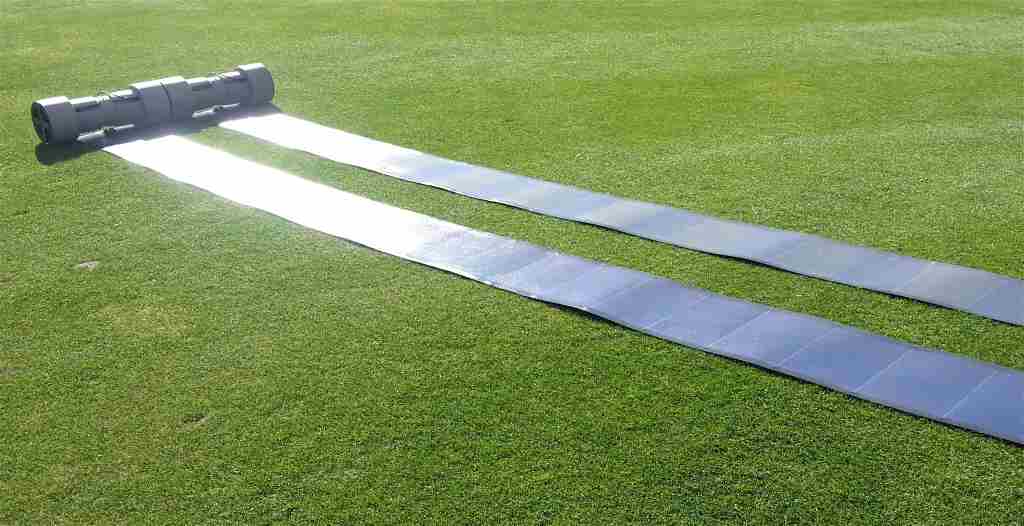
 Electric Power Virtually Anywhere (Riley): U.S. Patent No. 9,825,583
Electric Power Virtually Anywhere (Riley): U.S. Patent No. 9,825,583
Solar panel farms and roof-mounted solar panels are an increasingly common site across the U.S. Wouldn’t it be incredibly convenient if you could set up solar panels when and where you needed them for power? Thanks to this invention, you can. This patent introduces a portable solar panel system. Thin-film solar panels come in a roll, and they are simply rolled out onto the ground or on the surface of a body of water (they float). The invention includes a power inverter so the system can be adapted to produce 120 volts of AC current or whatever power is required by the user.
The solar panels can be laid out on the ground or on the surface of a lake, pond or other body of water – even the ocean – and they begin to produce power in minutes. The technology is totally scalable – add as many panels as are needed to produce the electric current that is required. Smaller sets of panels that are easier to transport can be linked together to produce whatever level of electric power is needed. The portable solar power system covered by this patent has multiple applications:
The acquirer of U.S. Patent No. 9,825,583 for a “Portable solar energy system” will own technology that will create an entirely new business segment in both the solar power sector and the portable power industry!
 Wind/Solar Generator (White): U.S. Patent No. 8,269,368
Wind/Solar Generator (White): U.S. Patent No. 8,269,368
This patent takes both wind and solar power-generation to the next technology. The invention covered by this patent starts with a totally new concept in wind power generation. A conical vortex moves air through the unit with as little interference as possible, reducing heat and improving efficiency. The cowl-housed design addresses many of the problems with the wind turbines of today – height requirements, whoosh noise, bird kills, high maintenance costs, downtime for maintenance, high-wind and low-wind downtime, and limited access to transmission lines – to name just a few. Solar panels provide power when wind speed is too low or too high. In addition, the technology is totally scalable, so units can be manufactured in various sizes and generation capacities.
U.S. Patent No. 8,269,368 for a "Wind and solar electric generator" would be a critical asset for any wind turbine OEM, or any business looking to break into the wind power sector.
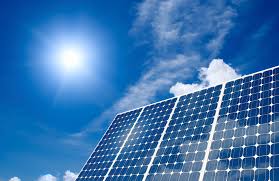 Swivel Solar Tracking Device (Moore): U.S. Patent No. 9,182,153 and PTO Application
Swivel Solar Tracking Device (Moore): U.S. Patent No. 9,182,153 and PTO Application
The invention covered by this patent describes a swivel tracking device that orients solar panels or arrays toward the sun throughout the daylight hours to harness the maximum amount of energy. This single device enhances the output efficiency of solar panels by 20% to 40% as compared to fixed solar panels, an improvement that other trackers require two mechanisms to achieve. This patent provides these key advantages:
The growing popularity of solar power as an alternative to – or supplement for – fossil fuels has led to significant growth in this sector. The solar panels themselves are a mature technology, so the focus is now on optimizing the power generated by solar panels. The swivel-positioning device provides a means of adding an additional dimension to power-generation optimization. The acquirer of U.S. Patent No. 9,182,153 for a “Ball bearing tracker assembly “ will have a unique strategic competitive advantage over its competitors.
 Off-Peak Power Conservation System (Evans): U.S. Patent and PCT Patent Application
Off-Peak Power Conservation System (Evans): U.S. Patent and PCT Patent Application
The supply of electric power provided by the local electric utility and other power sources – such as solar and wind – is totally unrelated to the demand for electric current. This portfolio covers a technology for a power conservation system with several advantages:
This portfolio includes U.S. Patent No. 7,915,760 for an “Electric power conservation system for storing power during off-peak hours” plus PCT Patent Application 2009076662 for an “Electric power conservation system,” and it creates a unique opportunity for a power generation or power distribution company, green power solution provider, or power storage hardware provider to leap frog its competitors in the area of energy conservation.
 Vertical-Axis, Scalable, Wind Turbine (Pohribnak): U.S. Patent No. 7,744,345”
Vertical-Axis, Scalable, Wind Turbine (Pohribnak): U.S. Patent No. 7,744,345”
This patent describes a next-generation wind power generator with several advantages over existing technologies:
U.S. Patent No. 7,744,345 for a “Wind power generator” would be a key acquisition for manufacturers of wind turbines and providers of turnkey wind turbine installations; wind energy products distributors; service providers for residential and commercial wind energy installations; irrigation systems manufacturers and installers; construction and emergency power providers; and home owners, farmers and businesses to provide power locally and economically or for net metering.
Patent Brokerage Prospectus: Contact [email protected] to receive an analysis of each portfolio that includes:
We offer patents in these technologies:




